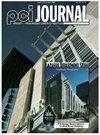Experimental investigation of a novel reinforced concrete buckling-restrained brace
IF 0.9
4区 工程技术
Q4 CONSTRUCTION & BUILDING TECHNOLOGY
引用次数: 0
Abstract
This paper describes an experimental investigation of a novel reinforced concrete buckling-restrained brace for precast concrete lateral load-resisting frame structures in seismic regions. The proposed brace uses ductile reinforcing bars with unbonded lengths across end gaps and bonded lengths at the middle region for lateral stiffness, strength, energy dissipation, and ductility. The experimental program included four isolated diagonal brace subassemblies subjected to reversed-cyclic pseudostatic lateral loading. Local buckling of the energy-dissipation bars across the end gaps is the most critical failure mode that can limit the ductility of the brace in compression. Up to this failure, the bonded and unbonded regions of the braces performed as designed. The results demonstrated the different deformation and stiffness behaviors of the braces in tension and compression. Subsequent loading to large tension displacements provided evidence of the large energy dissipation that can be expected if premature failure of the brace can be prevented. Simplified numerical models provided good predictions of the measured brace behavior until failure. This research featured the first set of tests for this brace, and the results highlighted adjustments needed to design and modeling to achieve the desired behavior of the brace. Recommendations for future research include improved shear dowel and confinement designs to prevent local buckling of the energy-dissipation bars and improved longitudinal reinforcement designs to prevent yielding of the energy-dissipation bars in the middle bonded region of the braces.一种新型钢筋混凝土抗屈曲支撑的试验研究
本文介绍了一种新型钢筋混凝土抗屈曲支撑的试验研究,该支撑适用于震区预制混凝土横向抗荷载框架结构。建议的支撑使用延性钢筋,在端间隙和中间区域具有非粘结长度,用于横向刚度,强度,能量耗散和延性。实验程序包括四个孤立的对角支撑子组件,承受反向循环假静力横向加载。消能杆端部局部屈曲是限制支撑抗压延性的最关键破坏形式。到目前为止,支撑的粘合和非粘合区域按设计进行。结果表明,支撑在拉伸和压缩作用下具有不同的变形和刚度行为。后续加载到大拉力位移提供了大能量耗散的证据,如果可以防止支撑的过早破坏,可以预期。简化的数值模型可以很好地预测所测支撑的破坏行为。这项研究的特点是该支架的第一组测试,结果突出了设计和建模所需的调整,以达到预期的支架行为。对未来研究的建议包括改进剪切销钉和约束设计,以防止消能杆的局部屈曲,改进纵向钢筋设计,以防止支撑中部粘结区域消能杆的屈服。
本文章由计算机程序翻译,如有差异,请以英文原文为准。
求助全文
约1分钟内获得全文
求助全文

 求助内容:
求助内容: 应助结果提醒方式:
应助结果提醒方式:


